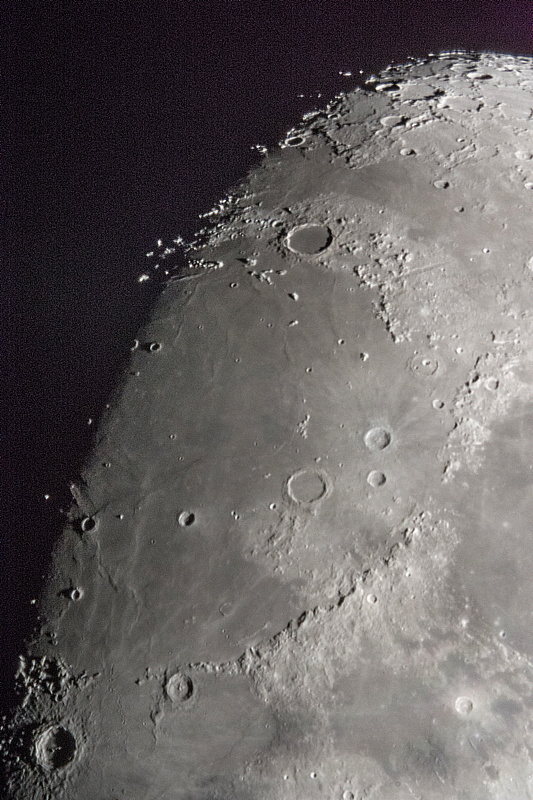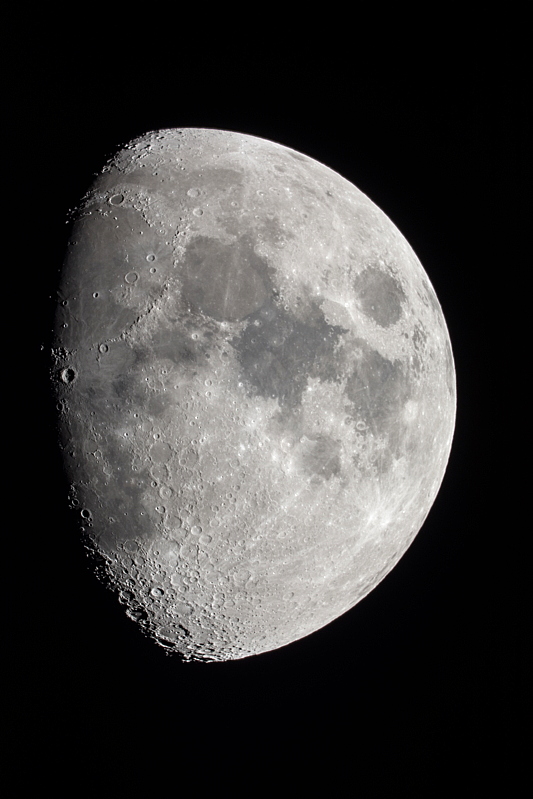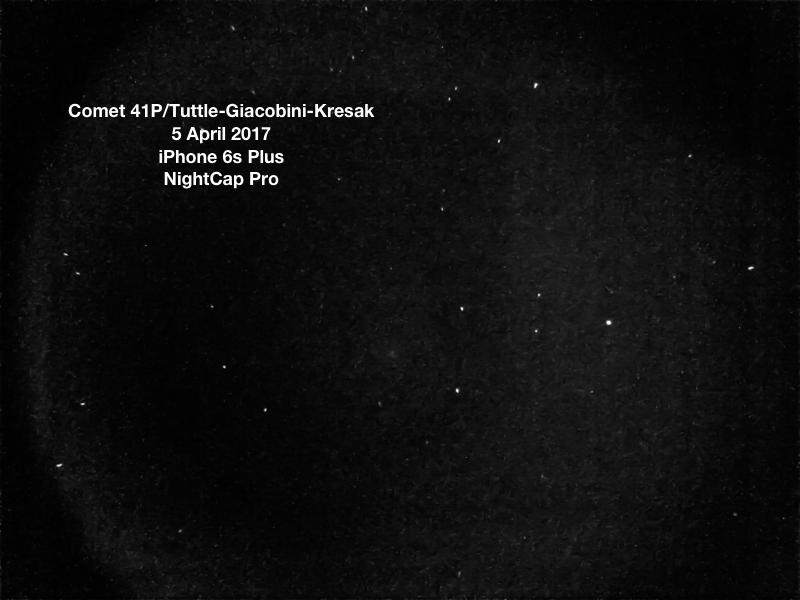Mercury, Moon with DSLR;
Comet 41P/T-G-K with iPhone & NightCap Pro
Posted: 6 April 2017
Monday, 3 April 2017, clouds and winds returned. Tuesday, 4 April, started out clear and calm but both the clouds and wind returned mid-day. The wind finally calmed down and the sky mostly cleared on Wednesday, 5 April.
|
Open: Wednesday, 5 April 2017, 1808 MST Temperature: 90°F |
Session: 1095 Conditions: Partly cloudy |
Equipment Used:
12" f/8 LX600 w/StarLock
2" 24mm UWA eyepiece
2" 9mm 100° eyepiece
2" 30mm eyepiece
Camera:
D7200 DSLR
iPhone 6s Plus
1813 MST: LX600 ON, StarLock OFF, High Precision OFF.
Viewed the planet Mercury, 102X and 271X. A nice crescent phase was visible.
Mounted the D7200 DSLR at prime focus + 2X PowerMate. The planet was too faint against the bright sky to focus. I began waiting for sunset, which would place the planet even lower in the sky. 1842 MST: clouds were now approaching the planet, which would make imaging even more difficult. Decided to use the Moon to focus. Then returned to Mercury. 1850 MST: sunset. 1856 MST: Mercury was still not visible in the finderscope. 1901 MST: finally picked up Mercury in the finderscope and began DSLR HD video recording (10 seconds each), 1/320sec, at various ISO settings. As expected, the seeing was not good enough for stacking any video, but I was able to find one good frame (ISO 1600):

The image above is full-frame to show the scale. The inset shows a magnified view of Mercury from the same frame.
1905 MST: ended Mercury imaging. Slewed to the Moon. Since the camera was set up for 2X imaging I took these photos along the lunar terminator, 1/250sec and 1/320sec, ISO 1600:



Removed the 2X PowerMate and added the focal reducer for this image of the waxing gibbous Moon, 1/320sec, ISO 200:

1924 MST: thin clouds were now in much of the sky, including at the Moon.
Switched to a 2" 30mm eyepiece. This provided a nice view of the Moon, 81X. I then attached the Levenhuk Smartphone Adapter to the 30mm eyepiece, mounted the iPhone 6s Plus, and adjusted the eyepiece-camera optical alignment in preparation for a later attempt at capturing Comet 41P/Tuttle-Giacobino-Kresak.
1936 MST: observatory Wi-Fi ON. Used SkySafari 5 Pro on the iPhone to GOTO Comet 41P. The comet was not yet visible in the 30mm eyepiece due to the still bright sky. 1944 MST: Comet 41P now faintly visible, 81X, but the sky was still too bright (due to twilight and the Moon) to try imaging the comet. 1951 MST: Wi-Fi OFF.
1957 MST: decided to try to capture the comet with the iPhone 6s Plus using the iOS app NightCap Pro. 2001 MST: StarLock ON for autoguiding (on a star). Surprisingly, the comet was actually faintly visible on the iPhone live view with NightCap Pro. I did some 1, 2, and 3 minute exposures, StarLock autoguided, using NightCap Pro (Long Exposure, Light Boost, ISO 8000, 1/3sec). Due to the thin clouds, autoguiding was not always very good. Can you find Comet 41P/Tuttle-Giacobino-Kresak in this image?

Mouseover or tap on image for pointer
If you can't find the comet, mouseover or tap on the image for a pointer to the comet.
I combined three images for this animation showing the comet's movement in 11 minutes:

2019 MST: StarLock OFF. Ended comet imaging.
2023 MST: viewed Comet 41P/T-G-K, 102X. The faint coma was visible even with the bright moonlit sky.
Then took a quick look at Jupiter, 102X, still low in the east and through a tree. The four Galilean Moons were visible.
2026 MST: LX600 OFF.
|
Close: Wednesday, 5 April 2017, 2034 MST Temperature: 65°F |
Session Length: 2h 26m Conditions: Thin clouds |
Comments are welcome using Email. Twitter users can use the button below to tweet this report to your followers. Thanks.
Cassiopeia Observatory Home Page
Copyright ©2017 Michael L. Weasner / mweasner@me.com
URL = http://www.weasner.com/co/Reports/2017/04/06/index.html
